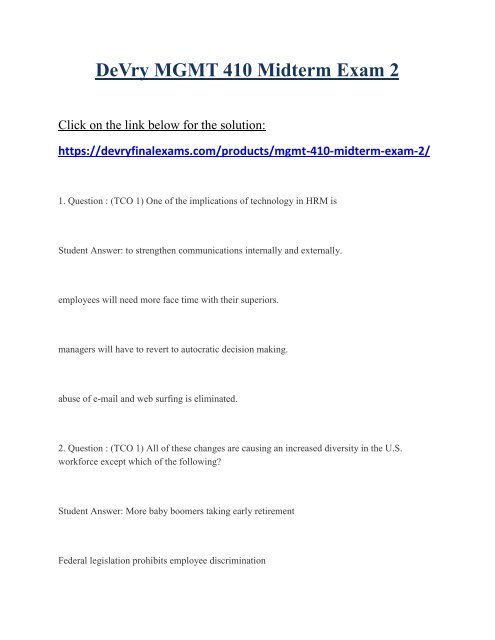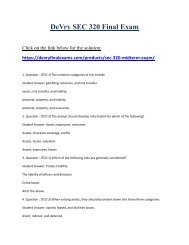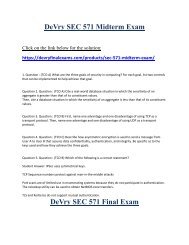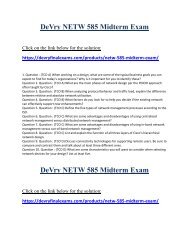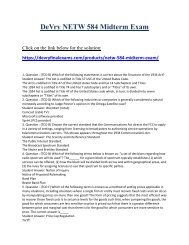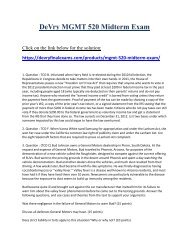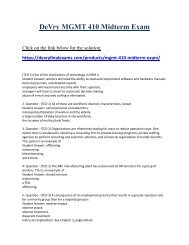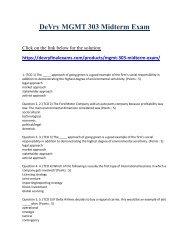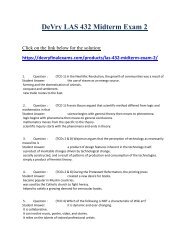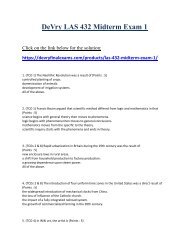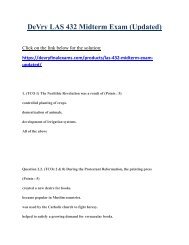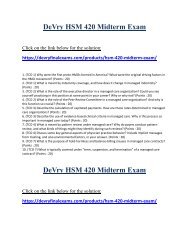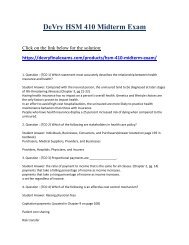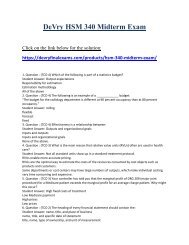MGMT 410 Midterm Exam 2
You also want an ePaper? Increase the reach of your titles
YUMPU automatically turns print PDFs into web optimized ePapers that Google loves.
DeVry <strong>MGMT</strong> <strong>410</strong> <strong>Midterm</strong> <strong>Exam</strong> 2<br />
Click on the link below for the solution:<br />
https://devryfinalexams.com/products/mgmt-<strong>410</strong>-midterm-exam-2/<br />
1. Question : (TCO 1) One of the implications of technology in HRM is<br />
Student Answer: to strengthen communications internally and externally.<br />
employees will need more face time with their superiors.<br />
managers will have to revert to autocratic decision making.<br />
abuse of e-mail and web surfing is eliminated.<br />
2. Question : (TCO 1) All of these changes are causing an increased diversity in the U.S.<br />
workforce except which of the following?<br />
Student Answer: More baby boomers taking early retirement<br />
Federal legislation prohibits employee discrimination
Passage of the Senior Citizens Freedom to Work Act<br />
Globalization lowers barriers to immigrants<br />
3. Question : (TCO 2) A small distribution organization uses a payroll company to provide<br />
employee compensation services and keep timesheet records and employee attendance history.<br />
This situation is an example of<br />
Student Answer: offshoring.<br />
centralized work surveillance.<br />
outsourcing.<br />
telecommuting.<br />
4. Question : (TCO 2) A large manufacturing organization with 20 geographically dispersed<br />
production facilities recently cut its HRM staff by 60%. Each site has a few generalists, but<br />
specialist needs in recruiting and selection planning, employment law, training, and benefits<br />
administration have been consolidated into one location. This situation is an example of<br />
Student Answer: shared services.
decentralized work surveillance.<br />
telecommuting.<br />
offshoring.<br />
5. Question : (TCO 3) When protected group members receive treatment different from other<br />
employees, this is called<br />
Student Answer: adverse impact.<br />
adverse attack.<br />
adverse treatment.<br />
disparate treatment.<br />
6. Question : (TCO 3) You are vice president of human resources of a large pharmaceutical<br />
manufacturer. Your firm has a longstanding tradition of promoting from within. New hires are<br />
fresh college graduates with no experience and no advanced degrees. Your firm is being sued by<br />
Ed, a 45-year-old MBA, who has attempted to apply for a general manager job. He knows the<br />
position is available because the incumbent died and the obituary was public information. He is
claiming age discrimination. Which of the following discrimination defenses should be<br />
employed?<br />
Student Answer: The 4/5 rule<br />
Geographical comparison<br />
Performance ratio comparison<br />
Seniority systems<br />
7. Question : (TCO 3) Which of the following laws extends employment protection of most<br />
forms of disability status?<br />
Student Answer: USERRA<br />
ADA<br />
ODHA<br />
PDA
8. Question : (TCO 4) Sharon, vice president of human resources for a large textile firm, is in a<br />
strategic restructuring meeting. The discussion topics include which one of the three production<br />
facilities to close. There are 40 employees at each of the facilities. When asked, “What should<br />
we tell the employees?” Sharon responds,<br />
Student Answer: “Tell them we are keeping the newest plant open for another 2 years. Transfer<br />
all employees with 20 years of seniority to that plant.”<br />
“Notify all workers immediately of probable plant closings within the next 4 years.”<br />
“If we close, workers in affected areas get 30 days notice or 90 days pay and benefits upon<br />
closing.”<br />
“Legally, we are not required to tell the employees anything unless we lay off 50 or more<br />
individuals.”<br />
9. Question : (TCO 5) When a job analyst watches employees directly or reviews films of<br />
workers on the job, which analysis method is being used?<br />
Student Answer: Group view method<br />
Observation method<br />
Structured method<br />
Individual view method
10. Question : (TCO 4) Which of the following is not one of the guidelines for administering<br />
discipline?<br />
Student Answer: Following the hot stove rule<br />
Provide no warning<br />
Be consistent and impersonal<br />
Making discipline actions progressive<br />
11. Question : (TCO 5) This job analysis method requires job incumbents to record their daily<br />
activities.<br />
Student Answer: Journal method<br />
Observation method<br />
Diary method<br />
Technical conference method
12. Question : (TCO 5) Where does recruitment occur in the strategic planning process?<br />
Student Answer: Before corporate goals and objectives are established<br />
After demands exceeds supply<br />
After the labor supply and demand are compared<br />
Before organizational mission is defined<br />
13. Question : (TCO 6) Jane is the director of recruiting for a large corporation. Which of the<br />
following is a warning signal that her efforts are not effective?<br />
Student Answer: Recruiting costs have increased 5% over the last 3 years.<br />
Because 25% of resumes are received through the Internet.<br />
Jane’s secretary spends more time acknowledging ad responses from qualified applicants than<br />
she did a year ago.<br />
Jane’s secretary spends more time acknowledging ad responses from under qualified applicants<br />
than she did a year ago.
14. Question : (TCO 6) A benefit of a good recruiting program is indicated by which of the<br />
following?<br />
Student Answer: More native speakers apply and fewer foreign nationals apply.<br />
Minimized cost of processing unqualified candidates.<br />
All applicants are encouraged to apply for jobs.<br />
Recruiting results in no women and minority applicants.<br />
15. Question : (TCO 6) Which is not a step in the selection process?<br />
Student Answer: Initial screening<br />
Background investigation<br />
Postemployment test<br />
Conditional job offer
16. Question : (TCO 6) Which of the following is a recruitment alternative that keeps employees<br />
longer than temporary employees and are employed by a firm.<br />
Student Answer: Leased employees<br />
Independent contractors<br />
Self-employed<br />
Temporary employees<br />
17. Question : (TCO 7) In the selection process, the employment testing should occur after<br />
Student Answer: the medical/physical examination.<br />
the initial screening.<br />
the conditional job offer.<br />
the completed application.
18. Question : (TCO 7) An activity included in pre-employment testing that creates a miniature<br />
replica of a job is called<br />
Student Answer: a performance simulation test.<br />
a work sampling.<br />
an assessment center.<br />
a global testing.<br />
19. Question : (TCO 7) Application forms typically include all of the following except<br />
Student Answer: a statement giving the employer the right to dismiss an employee for falsifying<br />
information.<br />
permission for the employer to obtain previous work history.<br />
name, address, and telephone number.<br />
marital status.<br />
20. Question : (TCO 8) Which is not an on-the-job training method?
Student Answer: Job rotation<br />
Simulations<br />
Apprenticeships<br />
Internships<br />
21. Question : (TCO 8) What is an employee development method that can allow the employee<br />
to share in decision making, learn by observing others, and investigate problems?<br />
Student Answer: Job rotation<br />
Adventure training<br />
Simulations<br />
Committee assignment<br />
22. Question : (TCO 8) Organizational development addresses system-wide change in the<br />
organization. If following the Lewin change process, which order of steps are correct?
Student Answer: Change, refreeze, unfreeze<br />
Unfreeze, change, refreeze<br />
Refreeze, change, unfreeze<br />
Unfreeze, refreeze, change<br />
23. Question : (TCO 9) Hector is a research scientist in a large company. He refuses to go to staff<br />
meetings but volunteers to attend conventions where he receives recognition for his<br />
accomplishments. He holds 17 patents (more than two for each year he has been with his<br />
company, and they are proudly displayed on his office wall), but will not work with his manager<br />
on quarterly goals. What is Hector’s Holland vocational preferences type?<br />
Student Answer: Realistic-investigative-enterprising<br />
Social-enterprising-conventional<br />
Social-conventional-realistic<br />
Investigative-conventional-artistic
Realistic-conventional-artistic<br />
24. Question : (TCO 9) Career stages are important to employee development. The traditional<br />
stages are<br />
Student Answer: entry-level, promotions, and retirement.<br />
graduate, hired, trained, and retired.<br />
exploration, establishment, midcareer, late career, and decline.<br />
entry-level, establishment, midcareer, late career, and retirement.<br />
25. Question : (TCO 9) Melissa prefers solitary work to large groups, asking questions rather<br />
than answering them, and making her own rules instead of following others. What Holland<br />
vocational preference model best represents her?<br />
Student Answer: Realistic-investigative-artistic<br />
Social-enterprising-conventional<br />
Social-conventional-realistic
Realistic-conventional-artistic<br />
1. Question : (TCO 3) Explain the need for equal employment opportunity laws in organizations.<br />
How has it impacted HRM? Defend your position.<br />
2. Question : (TCO 7) You have been ask by the VP of HR to review the hiring practices of the<br />
organization. You determine that you need to ensure you are using best practices and the process<br />
is in compliance. Provide, define, and explain the five best practices for hiring that the EEOC<br />
recommends. Be sure to state why these are best practices, and why the EEOC recommends that<br />
you follow them.<br />
3. Question : (TCO 8) You have just been promoted at the BBB Company and now have the<br />
responsibility of the employee orientation program. What components should be covered in the<br />
program? Explain what would be covered in your employee orientation program.<br />
DeVry <strong>MGMT</strong> <strong>410</strong> <strong>Midterm</strong> <strong>Exam</strong> 2<br />
Click on the link below for the solution:<br />
https://devryfinalexams.com/products/mgmt-<strong>410</strong>-midterm-exam-2/


